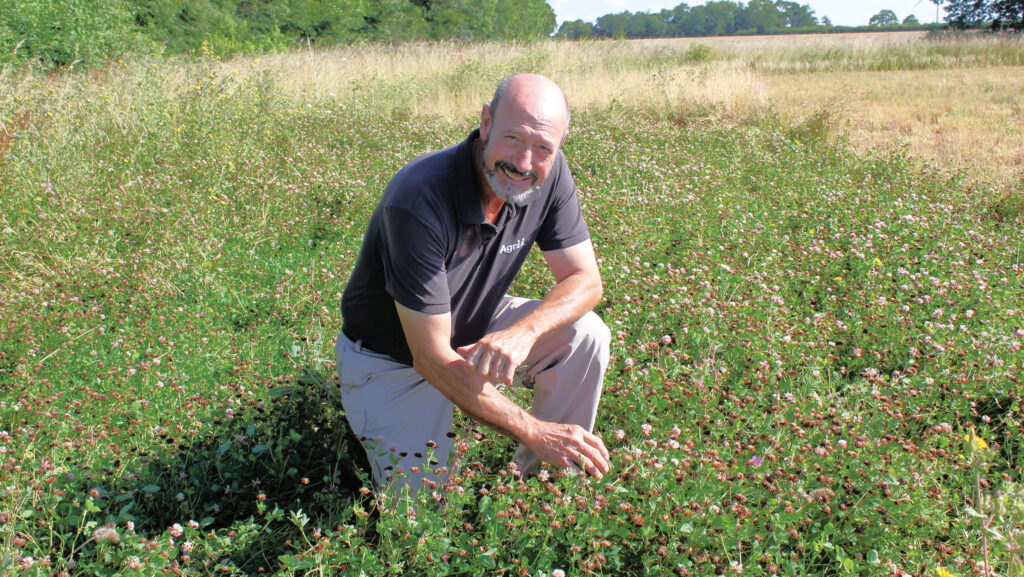Award-winning farmer shows ploughing can go with sustainability
 David Felce in one of his wildlife mixes © George Chancellor
David Felce in one of his wildlife mixes © George Chancellor Cambridgeshire farmer David Felce has been named this year’s winner of the BASF Rawcliffe Bridge Sustainability Award, for his focus on promoting biodiversity.
David, who farms with his wife Hayley at Midloe Grange Farm, Southoe, grows combinable crops for human consumption and uses the spring-sown legume fallow Sustainable Farming Incentive action (NUM3) as a break crop.
See also: Why two returning farmers pressed for regenerative change
That helps him keep on top of grassweeds and reduce herbicide use across the rotation, while improving soil health and supporting biodiversity.
Some 6ha of ancient species-rich ridge and furrow grassland adds to the ecosystem diversity, as does the farm’s proximity to site of special scientific interest ancient woodland.
“Biodiversity has always been important on this farm, so connecting and protecting these habitats has been key,” he says.
“Of course, we have to thrive as a business too. It’s lovely to have, and has a societal benefit, but the ancient grassland has always been the loss leader on the farm, despite renting it out for grazing.”
David shares labour and machinery with a neighbour, concentrates on getting the basics right and makes good use of technology.
According to the judges, he ‘lives and breathes’ sustainability and is delivering on every aspect, from soil health to water catchment management, as well as wildlife species diversity and integrated pest management.
Ploughing
He still ploughs in the autumn ahead of spring barley, with trials work showing a £540/ha benefit from taking a conventional establishment approach rather than using cover crops and direct drilling.
“It also means that there’s no need for a pre-emergence residual herbicide in spring barley,” he points out. “We sometimes have to use a graminicide, but that’s it.”
Old farm buildings have been repurposed and let, providing additional income, while David carries out some agronomy training and industry advisory work. He is now in the process of starting to sell biodiversity units.
“We’ve set up a habitat bank for biodiversity net gain and are on the national register,” he says. “It’s taken four and a half years and hard work to get to this point, but we’re now ready to go.”
That’s all part of the future-proofing of the farm and preparation for the next generation, he notes. “We’ve seized the opportunity while it’s there.”
Other finalists
Runners-up were Andrew Brown of Fairchilds Lodge Farm in Rutland, and Martin and Emma Hamer, who farm at Meadowsweet Farm in North Oxfordshire, both of which received high praise from the judging team.
The two farm businesses are committed to producing food and providing habitat, with the finalists emphasising that sustainability also means having a commercially viable farm.
Andrew, who grows wheat for Weetabix, has 60% of his arable land in environmental schemes and rents out permanent pasture on a grazing licence.
Having planted 3,500 trees, he keeps track of the wildlife on the farm, which includes 111 species of moths.
“The more, the better,” he says. “We’re seeing a win-win situation develop as beneficial numbers increase in our AB8 [flower rich] strips and soils improve.”
Martin and Emma Hamer have a mixed arable and beef farm, growing their own oats/beans protein blend and forage to finish cattle which arrive on the farm at 12 months.
Input use depends on the weather, says Emma, who stresses that they are creating a circular system by integrating livestock and arable for the wider benefits it offers.
For the Hamers, productivity and nature go hand-in-hand. “To ignore one at the expense of the other means that we wouldn’t have a viable commercial unit,” she says.
“The priority for us now is to try and understand whether we will still be able to do this in 10 years’ time.”
Previous winners – challenges ahead
The absence of a clear vision for farming means previous winners of the BASF sustainability accolade are facing some tough decisions, as they weigh up which direction to take.
David Hurn, who farms productive land in Norfolk, is looking at his rotation and considering growing more wheat.
“It would be a backwards step if we dropped break crops and bought the environmental areas back into production as biodiversity would suffer, but the figures support that,” he says.
As a result, he has decided to “tread water” for now. “The next three-to-four years will be very challenging, so hopefully the supply chain will step up.”
Last year’s winners, Cambridgeshire-based Matt and Lloyd Smith, point out that their farm starts with a disadvantage, as it has no hedges and only a handful of trees.
Matt says: “We don’t really have marginal areas.
“Even though environmental schemes are a cost to us, we’ve established margins and focussed on wildlife, addressing sustainability wherever possible.”
Matt describes himself as optimistic. “Unfortunately there’s no light at the end of the tunnel right now. The other option is that we just rent it out to grow maize.”
The 2023 winner, Colin Chappell, admits that he has halted all investment plans on his Lincolnshire farm as he waits to see what form public funding takes.
“We’re covered for the next two years with our Countryside Stewardship and Sustainable Farming Incentive agreements, but this farm floods every four years now.
“That makes our future uncertain.”
He is looking into a biodiversity net gain offer for 8ha, but is wary of committing to a long-term deal and delivering the necessary uplift.
“There are no normal years anymore so we have to look at all the options.”
Award partners
Organised by BASF, partners in the Sustainability Award 2025 include The Andersons Centre, the Country Trust and the Royal Entomological Society

